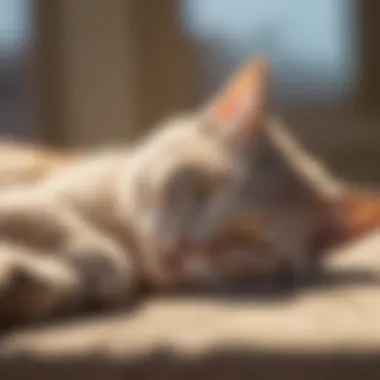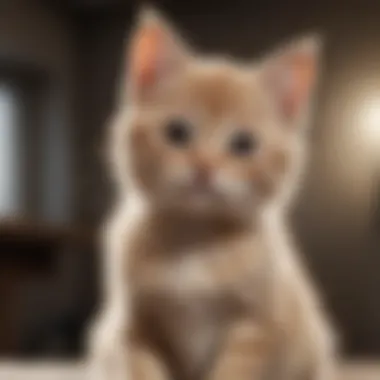Unveiling the Fascinating Progression of Aging in Kittens


Pet Care Essentials
Daily Nutrition Requirements
Providing proper nutrition is essential for the healthy growth and development of kittens. A balanced diet rich in high-quality protein is crucial for their muscle and tissue development. It is important to consult with a veterinarian to determine the appropriate feeding schedule and portion sizes based on the kitten's age and weight. Ensuring access to fresh water at all times is also key to maintaining their overall health.
Exercise and Playtime
Physical activity and play are essential for kittens to develop their coordination, strength, and agility. Engaging in interactive play sessions with appropriate toys not only provides exercise but also stimulates their mental faculties. Setting aside dedicated playtime each day helps kittens burn off excess energy and prevents behavioral issues associated with boredom.
Grooming Tips
Introducing kittens to grooming practices early on can help them acclimate to regular grooming routines. Brushing their fur gently, trimming their nails, and cleaning their ears and teeth are all part of maintaining good hygiene. Additionally, regular grooming sessions allow pet owners to check for any skin issues, parasites, or abnormalities that may require veterinary attention.
Health and Wellness Check-ins
Regular veterinary check-ups are vital for monitoring the overall health of kittens. Vaccinations, deworming, and parasite control are essential components of preventive care. Observing changes in behavior, appetite, or bathroom habits can alert pet owners to potential health concerns that warrant immediate attention. Being proactive about healthcare contributes to ensuring a long and healthy life for kittens.
Introduction
Why Understanding Kitten Aging is Important
The importance of comprehending kitten aging rests on its pivotal role in fostering healthy relationships between pet owners and their feline friends. By gaining insights into the aging process, individuals can anticipate and address the evolving needs of kittens at different life stages. This understanding aids in the implementation of appropriate care strategies, encompassing nutrition, socialization, and healthcare, to promote optimal development and overall well-being. Additionally, being cognizant of kitten aging facilitates early detection of potential health issues, enabling prompt intervention and management. Ultimately, a profound understanding of kitten aging not only enhances the quality of life for the pets but also enriches the bond between humans and their beloved companions.
Overview of Kitten Developmental Stages
Charting the course of kitten developmental stages unveils a captivating narrative of growth and transformation. From the delicate newborn phase to the flourishing adulthood stage, each period is marked by distinct milestones and characteristics. Newborn kittens emerge into the world with fragile bodies and developing senses, relying entirely on maternal care for survival. As they progress into infancy, they begin to explore their surroundings, exhibit playful behaviors, and undergo crucial milestones such as weaning and motor skills development. The journey continues through the juvenile and sub-adult stages, where kittens experience significant physical and behavioral changes, leading up to the maturity phase characterized by reproductive readiness and established behavior patterns. Understanding these developmental stages equips pet owners with the knowledge needed to provide appropriate care and guidance tailored to the unique requirements of kittens at each phase of their growth.
Key Factors Affecting Kitten Aging
Numerous factors intricately influence the aging process in kittens, shaping their growth trajectory and overall well-being. Genetics play a fundamental role, determining aspects such as size, coloration, and predisposition to certain health conditions. Environmental factors, including diet, living conditions, and social interactions, exert a profound impact on kitten development, influencing everything from immune system strength to behavioral patterns. Furthermore, proper healthcare practices such as vaccination, parasite control, and regular veterinary check-ups are instrumental in ensuring the longevity and vitality of kittens. By comprehending and embracing these key factors, pet owners can proactively nurture the growth and health of their feline companions, laying a solid foundation for a fulfilling and harmonious relationship.
Newborn Stage
In this section of the article, we delve into the crucial Newborn Stage in a kitten's life. Understanding this initial phase is fundamental as it sets the foundation for the cat's future development. The Newborn Stage encompasses the period right after birth and the first few hours of the kitten's life, where they are at their most vulnerable. Recognizing and accommodating the specific needs of newborn kittens is essential for their survival and well-being. Pet owners must grasp the characteristics of this stage to provide the necessary care and support required for healthy growth.
Characteristics of Newborn Kittens


Birth and First Hours of Life
The Birth and First Hours of Life are pivotal moments in a newborn kitten's journey. During this time, kittens are entirely dependent on their mother for nourishment, warmth, and protection. The act of giving birth and the immediate postpartum period are critical for the mother to bond with her offspring. Kittens are born blind and deaf, relying solely on their sense of touch and smell to locate their mother and navigate their environment. The mother's instinctual care during these initial hours lays the groundwork for a strong maternal bond, fostering the kittens' emotional stability and security. Understanding the intricacies of this phase aids in appreciating the fragility of newborn kittens and the importance of a nurturing environment.
Physical Appearance
The Physical Appearance of newborn kittens is characterized by their small size, closed eyes, and underdeveloped bodies. At birth, kittens weigh only a few ounces and appear fragile and delicate. Their closed eyes, fused shut to protect fragile developing retinas, gradually open within one to two weeks. The soft, sparse fur of newborn kittens provides minimal insulation, necessitating warm and cozy surroundings for proper thermoregulation. Observing and monitoring the physical changes in a newborn kitten's appearance is crucial to ensure their health and development progress optimally.
Behavioral Patterns
Understanding the Behavioral Patterns of newborn kittens sheds light on their instinctual behaviors and communication cues. Newborn kittens spend the majority of their time sleeping to conserve energy for growth and development. They exhibit reflex actions, such as crawling toward the mother's warmth and vocalizing for attention. The kneading motion they make with their paws while nursing promotes milk flow and creates a comforting sensation. Recognizing these instinctual behaviors helps pet owners decipher the needs and comfort levels of newborn kittens, fostering a nurturing and supportive environment for their early stages of life.
Infant Stage
The Infant Stage is a pivotal phase in the development of kittens, playing a crucial role in their overall growth and well-being. Understanding this stage is essential for pet owners to provide adequate care to their feline companions. During the Infant Stage, kittens transition from the vulnerability of the newborn stage to become more active and independent. This phase marks the beginning of important milestones in their development and lays the foundation for their future health and behavior. It is imperative for pet owners to closely monitor their kittens during this period and ensure they receive proper nutrition and attention to support their growth.
Progression from Newborn to Infant
Milestones Achieved
Milestones Achieved during the progression from newborn to infant stage signify significant advancements in a kitten's development. These milestones include gaining the ability to walk steadily, starting to explore their surroundings, and developing social interactions with littermates and humans. Achieving these milestones is vital as it indicates normal growth and cognitive abilities in kittens. Pet owners should celebrate these achievements as they showcase the healthy progression of their feline companions.
Feeding Transition
The Feeding Transition phase is a critical aspect of a kitten's development, marking the shift from solely relying on mother's milk to incorporating solid foods into their diet. This transition introduces kittens to a new source of nutrients essential for their growth and establishes healthy eating habits. Choosing the right type of food and ensuring a smooth transition is key to preventing nutritional deficiencies and digestive issues. Pet owners must carefully monitor their kittens' progress during this stage and provide a balanced diet tailored to their specific needs.
Motor Skills Development
Motor Skills Development plays a crucial role in the physical and cognitive advancement of kittens during the Infant Stage. This phase involves kittens improving their coordination, balance, and strength as they learn to walk, run, and play. Developing motor skills is essential for kittens to explore their environment, engage in physical activities, and interact with their surroundings effectively. Encouraging playtime and providing enriching toys can aid in enhancing their motor skills while fostering a healthy and active lifestyle for kittens.
Weaning Stage
In the comprehensive exploration of the aging process in kittens, the Weaning Stage plays a pivotal role in the transition from solely relying on mother's milk to beginning a diet of solid food. This essential phase not only marks a significant milestone in the kitten's development but also holds key benefits for their overall growth and well-being. Understanding the intricacies of the Weaning Stage is crucial for pet owners to facilitate a smooth and healthy progression for their feline companions.
Transitioning to Solid Food
Signs of Readiness


Delving into the Signs of Readiness during the Weaning Stage sheds light on specific behavioral and physiological indicators that signify a kitten's preparedness to embrace solid food. These signs include increased curiosity towards food, mouthing or chewing behavior, and a decrease in nursing frequency. Recognizing these key characteristics is vital in ensuring a successful transition to solid food, as they denote the kitten's natural inclination towards exploring new sources of nutrition. By paying close attention to these cues, pet owners can effectively support their kittens' nutritional advancement during this critical phase.
Weaning Process
The Weaning Process is a gradual methodical approach that introduces kittens to solid food while gradually reducing their dependency on mother's milk. This phase involves offering soft, palatable food to kittens alongside nursing sessions, allowing them to adapt to different textures and tastes. The Weaning Process aims to instill dietary independence in kittens, encouraging them to consume solid food more consistently. One of the standout features of the Weaning Process is its ability to foster kittens' autonomy and self-sufficiency in terms of feeding, preparing them for a diet devoid of maternal milk.
Nutritional Considerations
Addressing Nutritional Considerations during the Weaning Stage is paramount for providing kittens with a balanced and nourishing diet essential for their growth and development. Ensuring that the solid food offered is nutritionally dense and specifically formulated for kittens' needs is imperative. Pet owners need to consider factors such as protein content, vitamins, and minerals in the food, aligning with kittens' requirements during this crucial stage. By incorporating high-quality nutrition into the Weaning Stage, owners can safeguard their kittens' health and wellness, setting a strong foundation for robust growth and vitality.
Juvenile Stage
In the spectrum of cat development, the Juvenile Stage occupies a crucial position, signifying the transition from playful adolescence to more sophisticated adulthood. This pivotal phase is marked by significant physical and behavioral changes, making it essential for pet owners to be well-informed and proactive in their care routines. Understanding the Juvenile Stage equips individuals with the knowledge necessary to support their kittens effectively through this formative period.
At this juncture, cats undergo rapid growth spurts, refining their motor skills and agility while exploring their surroundings with newfound curiosity. Socialization during the Juvenile Stage plays a pivotal role in shaping a cat's demeanor, laying the foundation for healthy interactions with other animals and humans. Monitoring the health of kittens during this phase is imperative to catch any potential issues early on, ensuring their well-being and preventing future complications. The Juvenile Stage is a critical period that demands attention to detail and a deep understanding of feline behavior and development.
Adolescent Development
Puberty Onset
The onset of puberty marks a significant milestone in a cat's life, signifying the beginning of sexual maturation. This period is characterized by hormonal changes that influence a cat's behavior and physical development. Puberty onset typically occurs between 5 and 9 months of age, varying depending on the breed and individual cat. Understanding puberty onset is crucial for pet owners to observe and manage their cat's evolving needs and behaviors.
Puberty onset brings forth distinct characteristics such as increased territorial behavior, vocalization, and sexual interest. These changes may manifest differently in male and female cats but are universal indicators of the transition into reproductive maturity. While puberty onset is a natural and inevitable phase in a cat's life cycle, it necessitates attentive observation and potential adjustments in care routines to accommodate the cat's changing requirements.
Socialization Skills
Developing strong socialization skills is paramount for cats, especially during the adolescent stage. Socialization enables cats to navigate various environments confidently, interact harmoniously with other animals, and form enduring bonds with their human companions. Cats that lack adequate socialization may exhibit fearfulness, aggression, or anxiety in unfamiliar situations, underscoring the significance of this developmental aspect.
Key characteristics of excellent socialization skills include adaptability, resilience, and the ability to communicate effectively through body language and vocalizations. Cultivating socialization skills in cats contributes to their emotional well-being, fosters positive relationships, and mitigates behavioral issues. Pet owners play a crucial role in facilitating social interactions and providing enriching experiences to help cats develop robust socialization skills.
Health Monitoring
Vigilant health monitoring is essential during a cat's adolescent development to detect early signs of illness, nutritional deficiencies, or behavioral changes. Regular veterinary check-ups, proper nutrition, and grooming practices are integral components of effective health monitoring during this critical phase. Observing and documenting any deviations from normal behavior or physical condition enables timely intervention and ensures the cat's continued health and well-being.
Health monitoring encompasses various aspects, including weight management, dental health, parasite control, and vaccination schedules. Being proactive in monitoring a cat's health not only safeguards against potential health issues but also strengthens the bond between pet owners and their feline companions. Prioritizing health monitoring throughout a cat's adolescence sets the foundation for a lifetime of vitality and happiness.
Sub-Adult Stage


In the context of feline development, the Sub-Adult Stage plays a pivotal role in shaping the overall well-being and growth trajectory of kittens. This phase marks a critical transition from juvenile to adult traits, necessitating specific attention and care from pet parents. Understanding this stage is essential for feline enthusiasts seeking to provide optimal support and stewardship during their pet's maturation process. By shedding light on the distinct characteristics and requirements of the Sub-Adult Stage, this section aims to equip readers with valuable insights to navigate this crucial period effectively.
Pre-Adult Growth Phase
Physical Changes
Delving into the realm of Physical Changes during the Pre-Adult Growth Phase unveils a spectrum of transformations in a kitten's anatomy and physiology. These alterations, ranging from muscular development to weight fluctuations, significantly impact the kitten's overall health and vitality. Emphasizing the significance of proper nutrition and exercise, these changes underscore the importance of laying a strong foundation for the cat's physical well-being. By elucidating the nuances of these Physical Changes, pet owners can proactively promote their kitten's growth and development, ensuring they thrive into healthy adulthood.
Behavioral Shifts
Navigating the domain of Behavioral Shifts reveals a profound evolution in a kitten's cognitive and emotional tendencies. From increased independence to altered play patterns, these shifts mirror the cat's progression towards adult behaviors and instincts. Understanding these changes is vital for fostering a harmonious relationship between pet and owner, enabling effective communication and bonding. By recognizing and adapting to these Behavioral Shifts, individuals can cultivate a supportive environment that nurtures the kitten's social and mental well-being, enriching the human-feline dynamic.
Nutritional Requirements
Exploring the realm of Nutritional Requirements unravels the intricate balance of nutrients essential for a kitten's growth and vitality. From protein-rich diets to targeted supplements, meeting these requirements is instrumental in safeguarding the cat's health and development. Tailoring nutrition to suit the specific needs of the Sub-Adult Stage is crucial for promoting optimal growth and preventing nutritional deficiencies. By dissecting the nuances of Nutritional Requirements, pet caregivers can make informed choices regarding their feline companion's diet, ensuring their well-being is prioritized at every stage of their life cycle.
Adulthood Stage
Reaching Maturity
Reproductive Maturity:
When delving into Reproductive Maturity in kittens, it unveils a significant aspect of their development. This phase marks the point where kittens attain sexual maturity, enabling them to reproduce. The key characteristic of Reproductive Maturity lies in the ability of kittens to engage in mating behaviors and conceive offspring. This aspect is crucial in the context of the article as it elaborates on a pivotal stage in the life cycle of feline companions. Understanding Reproductive Maturity sheds light on the natural reproductive instincts of cats and the responsibilities that come with managing breeding.
Established Behavior Patterns:
Exploring Established Behavior Patterns among adult cats provides valuable insights into their psychological and social development. This aspect focuses on the behaviours that are solidified and consistent in adult cats, shaping their interactions with humans and other animals. The key characteristic of Established Behavior Patterns is the predictability and reliability in the way adult cats respond to stimuli, establishing a sense of routine and stability in their interactions. This discussion is essential in the article as it emphasizes the importance of understanding and respecting the established behaviors of adult cats to foster a harmonious relationship.
Health Considerations:
Delving into Health Considerations in the Adulthood Stage is crucial for ensuring the overall well-being and longevity of feline companions. This aspect highlights the specific health concerns that become more prominent as cats transition into adulthood. The key characteristic of Health Considerations involves addressing issues such as weight management, dental care, and age-related health conditions prevalent in adult cats. Understanding these considerations is vital for pet owners as it empowers them to provide the necessary medical attention, dietary adjustments, and preventive measures to support the health and vitality of their adult cats.
Conclusion
As we conclude our exploration of the aging process in kittens, it becomes evident that understanding the various developmental stages these feline companions go through is imperative for pet owners. By familiarizing ourselves with the nuanced changes from birth to maturity, we can provide optimal care and support to our kittens, ensuring their well-being and happiness throughout their growth journey. Each phase, from infancy to adulthood, holds crucial insights that enable us to tailor our care routines accordingly, emphasizing the significance of being attuned to their evolving needs.
Summary of Key Points
Reflection on Kitten Aging Process
Diving into the reflection on the kitten aging process allows us to appreciate the intricate transformations these animals undergo as they mature. This aspect not only highlights the physical changes but also delves into the behavioral shifts and developmental milestones that shape a cat's journey from infancy to adulthood. Understanding the reflection on kitten aging process is vital for pet owners as it provides a holistic view of the growth stages, aiding in recognizing signs of progress and potential concerns. Additionally, by comprehending this facet, individuals can foster a deeper bond with their kittens, fostering a nurturing environment that promotes optimal development.
Tips for Supporting Kitten Growth
The tips for supporting kitten growth section offers practical advice and recommendations to enhance the well-being of feline companions at every life stage. From dietary considerations to socialization techniques, these tips cater to the diverse needs of kittens, empowering pet owners to provide comprehensive care. Emphasizing aspects such as proper nutrition, interactive play, and regular health check-ups, this segment serves as a valuable resource for individuals looking to optimize their kitten's growth and development. By incorporating these tips into daily routines, pet owners can create a supportive environment that nurtures their kitten's physical, emotional, and behavioral needs.







